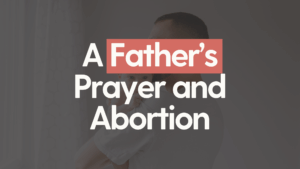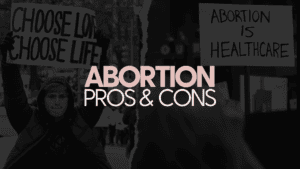When I began my medical residency, I believed that abortion on demand was simply a matter of women’s rights – the “right to choose.” I felt that a woman should have control over her body and not be forced to bear a child she didn’t want. I also believed it was wrong to bring unwanted children into an overpopulated world where they might be neglected or abused.
During my residency program I was trained in first trimester abortions. I also sought out special training in second trimester “D&E” procedures – otherwise known as dismemberment abortions. After each procedure I had to examine the tissue carefully to account for all the body parts, to make sure nothing was left that might cause infection or bleeding.
At that time a human fetus seemed no different to me than the chicken embryos I dissected in college. I could view them with strictly scientific interest, devoid of the emotions with which I would normally view a baby. I wasn’t heartless … I had just been trained to compartmentalize my feelings. If I had a patient come in who had experienced a miscarriage or a stillbirth, and she had wanted the baby, then I was distraught for her and empathized with her pain. In my mind, the difference was whether the baby was wanted or unwanted.
The lesser of two evils?
After I got my medical license, I was able to get a job moonlighting at a women’s clinic in Gainesville, Florida, where I performed abortions. Although the need for the procedure was unfortunate, I reasoned that abortion was the lesser of two evils since I was doing something to promote the well-being of women.
I could also make a lot more money doing abortions than I could working in an emergency room. I enjoyed the technical challenges of the procedure, and I prided myself on being really good at what I did. The only time I had any qualms about performing abortions was when I had my neonatal care rotation and realized that some of the babies I was trying to save in the NICU were around the same age as the babies I was aborting. Ultimately, I was able to rationalize these thoughts and push my reservations
aside.
I became pregnant during my last year in residency, but continued to do abortions. My baby, after all, was wanted. Theirs were not. The first time I returned to the clinic after my delivery, however, I was confronted with three cases that changed my way of thinking.
Making the connection
In the first case, I discovered that I had already performed three previous abortions on a girl scheduled that morning. When I protested doing yet another abortion, I was told by the clinic staff that it was her right to use abortion as her method of birth control and that I had no right to pass judgment on her or to refuse to do the procedure. I told them it was fine for them to say that, but that I was the one who had to take the life of the baby. The young woman got her abortion and, despite my urging, refused birth control.
The next situation involved a woman who, when asked by a friend if she wanted to see the fetal tissue, replied “No! I just want to kill it.” I felt like saying, What did that baby ever do to you?
The third case brought me to tears. The woman was a mother of four who felt like she couldn’t support another child. She cried throughout her entire time at the clinic.
Through these three cases, I finally made the emotional connection between fetus and baby.
What struck me in particular was the apathy of the first patient and the hostility of the second toward the fetuses inside them – contrasted with the sorrow and misery of the third woman who knew what it was to have a child. I recognized that the innocent victim in all of this was the baby. Being unwanted was no longer enough justification for me to take the child’s life.
And that was the end of my abortion career.
The truth sinks in
I discovered later that few doctors perform abortions for very long. Though the women who want abortions are told that their pregnancy is just a blob of tissue, the abortionist knows exactly what he or she is doing, because the abortionist must count the body parts after each procedure.
Eventually the truth sinks in. OB-GYNs especially must deal with this internal conflict, because they are normally concerned about the welfare of both their patients. Yet in an abortion, the doctor is ending the life of one of them. Perhaps that’s why so many OB-GYNs don’t do abortions.
And yet, although I stopped performing abortions, I remained a staunch supporter of abortion rights and continued to refer patients for abortions. I agreed to act as a medical director for Planned Parenthood early on in my medical practice, and I continued to hold those beliefs even after I became a Christian a few years later.
My views on abortion finally began to change as I noticed how well the women who kept their unplanned pregnancies were doing, especially compared with those who were struggling with the emotional aftermath of an abortion. That wasn’t what I expected, and it was definitely inconsistent with the feminist rhetoric I had embraced. My stance also began to soften as I watched children in my church who could
have been aborted, including one with Down syndrome, grow up into wonderful young people.
I was no better
But it wasn’t until a Christian friend gave me an article comparing abortion to the Holocaust that I changed my opinion completely. My father had been part of a unit that helped liberate a concentration camp during WWII, so I grew up with those stories and pictures. I could never understand how the Nazi doctors could do what they did. As I thought about my previous actions and behavior, however, I began to understand how the Nazis were able to dispassionately exterminate so many people and how physicians could justify the atrocious experiments they performed in the name of science.
Just as I did not consider the humanity of fetuses, the Nazis did not consider the Jews to be human beings. I realized that I was no better than they were.
Read: A Message to Women From a Former Abortionist
For the first time, I saw myself as a mass murderer. I was devastated. I asked for God’s forgiveness and became pro-life. God is merciful and has surrounded me with loving friends who helped get me the counseling and prayer that I needed to heal.
God was faithful
Not long after that I responded to an email looking for experts willing to testify in support of the federal Partial-Birth Abortion Ban Act. That opportunity didn’t work out, but I subsequently testified in several
states. I defended the ban in state courts and eventually testified before a House committee in Washington, D.C. God was faithful during that time and gave me just what I needed to keep going. Every time I wanted to quit or was afraid, God led me to an encouraging Scripture.
Eventually my life returned to normal. In 2014 I retired from medicine, yet I prayed that God would still use me. In 2016 I got a call asking me to testify once more, this time before a U.S. Senate committee hearing. Since then I have joined the Charlotte Lozier Institute and have continued to testify at the state and federal level. Unlike before, when I needed continual confirmation that I was doing what God wanted, I now endeavor to accept each new opportunity that comes along.
One of the joys of practicing obstetrics is later getting to meet with the babies you helped deliver. (In my case, some of those same children are now grown and with babies of their own!) For me, however, that joy is often bittersweet. As I greet them once again and discover who they have become, I am reminded of all the people I will never meet … because I aborted them















